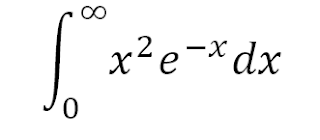I told you I wanted to treat this as the dot product of x-squared and e-to-the-minus-x; but the "dot product" idea only works when you integrate over the whole range of the function from minus to plus infinity. So I figured out that you can "fix" this problem by using the integral of the Dirac Delta function, also known as the unit step or the Heaviside Step function. I like to draw it graphically like so:
Oh yeah...I slipped in one more thing. The D-squared operator is the differentiation operator. I can throw it in with impunity because when it operates on the exponential, it just returns the same function. So I can throw it in for free.
And now comes the good part. Instead of operating to the right, I operate to the left. I differentiate x-squared, because I'm allowed to operate in either direction. But there's a catch...it's not just x-squared: it's x-squared multiplied by the unit step!
We can easily do this differentiation using the product rule compounded twice. You know:
(fg)'' = f''g + 2f'g' + fg''
The easiest way to differentiate those step functions is pictorially. I hope the following picture is self-explanatory:
Are you still with me? This is what we get when we differentiate to the left. Now we just have to multiply all these terms by the right-hand side, namely exp(-x). This is what we get:
Remember, these are my "dot products", which means they are really just integrals between plus and minus infinity. And they're easy to evaluate! The one on the right hand side is just the exponential multiplied by twice the unit step, which kills everything to the left of zero. We know this integral evaluates to 2*1 = 2.
What about those crazy integrals with the delta function and its derivatives? Those are especially nice, because the delta functions kill everything except what's going on right at the origin. You can actually prove this with integration by parts (the "traditional" way), but you should be able to convince yourself of it pictorially.
Why don't you think about that and I'll finish it off when we return...





Tidak ada komentar:
Posting Komentar